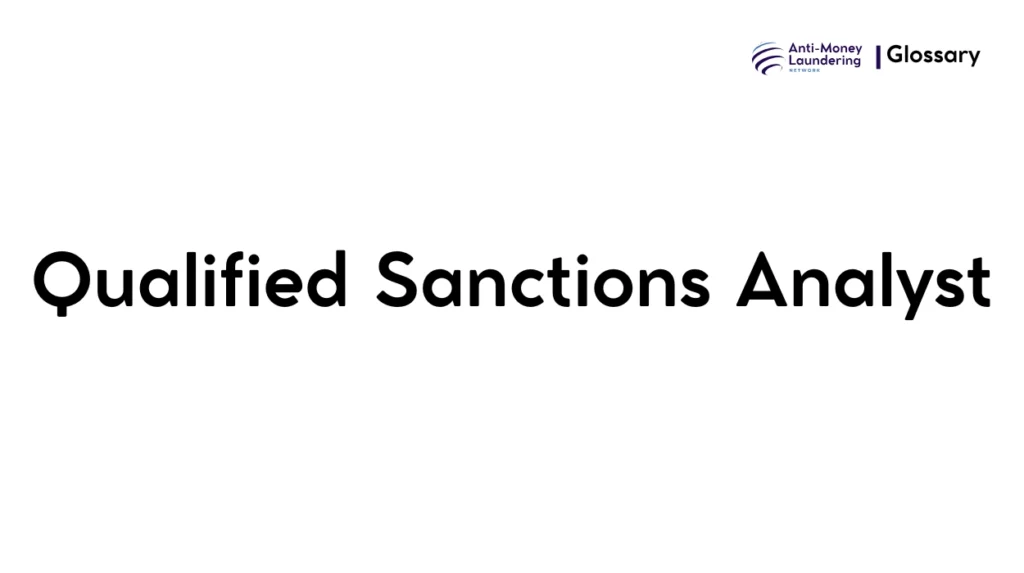Definition
A Qualified Sanctions Analyst in AML is an expert tasked with evaluating and monitoring financial activity for compliance with sanctions laws and regulations. This role involves screening customers, transactions, and entities against updated sanctions lists issued by regulatory bodies such as the Office of Foreign Assets Control (OFAC), the United Nations, the European Union, and national authorities.
Their analysis ensures that institutions do not facilitate transactions involving sanctioned persons, entities, countries, or activities, which is a critical component of AML efforts.
Purpose and Regulatory Basis
Role in AML
Sanctions compliance is a core pillar of AML, aimed at cutting off financial support to illicit actors. Qualified Sanctions Analysts safeguard financial institutions by enforcing sanctions laws that complement AML rules. Their role is to identify prohibited engagements early and prevent legal penalties, financial loss, and reputational damage.
Key Regulations
- Financial Action Task Force (FATF): Provides global AML guidance, urging sanctions screening as part of risk-based approaches.
- USA PATRIOT Act: Mandates financial institutions to adopt watchlist screening and enhanced due diligence for sanctioned entities.
- EU Anti-Money Laundering Directives (AMLD): Require member states to enforce sanctions screening aligned with UN and EU blacklists.
- OFAC Regulations: U.S. Treasury sanctions enforcement authority that sets comprehensive prohibitions.
- United Nations Security Council Resolutions: International sanctions regimes targeting specific countries or actors.
Qualified Sanctions Analysts ensure adherence to these regimes, integrating sanctions compliance with broader AML controls.
When and How it Applies
Real-World Use Cases
- Account Opening: Sanctions screening during customer onboarding to prevent prohibited relationships.
- Transaction Monitoring: Continuous review of transfers and payments for sanctions hits.
- Third-Party Relationships: Screening partners, suppliers, and intermediaries.
Triggers
- Matches on sanctions lists
- Alerts from automated screening systems
- Identification of politically exposed persons (PEPs) with sanctions risks
Examples include blocking financial transfers to sanctioned countries or freezing assets of designated entities detected during monitoring.
Types or Variants
Classifications
- Screening Analyst: Focuses primarily on automated and manual sanctions list screening.
- Investigative Sanctions Analyst: Handles escalated cases requiring deeper analysis, legal interpretation, and reporting.
- Sanctions Compliance Officer: Senior role overseeing program integrity and regulatory reporting.
The “Qualified” designation often refers to certification or proven expertise in sanctions screening methodologies, legal frameworks, and risk assessment.
Procedures and Implementation
Steps for Compliance
- Sanctions List Screening: Automated and manual checks against global watchlists during onboarding and ongoing monitoring.
- Alert Triage and Investigation: Analysts review flagged matches to determine validity and escalate suspicious cases.
- Enhanced Due Diligence (EDD): Deep investigation on flagged customers or transactions.
- Blocking or Rejecting Transactions: Immediate action on confirmed sanctions matches.
- Regulatory Reporting: Filing Suspicious Activity Reports (SARs) or sanctions-related reports with authorities.
Systems and Controls
- Use of advanced screening software with fuzzy matching
- Integration with transaction monitoring platforms
- Regular list updates and audit trails
- Employee training on sanctions compliance
Institutions must embed these controls within their AML programs to meet regulatory expectations.
Impact on Customers/Clients
Rights and Restrictions
- Customers flagged may experience delays, account restrictions, or transaction blocks.
- Institutions must balance compliance with customer service and legal obligations.
- Clients are entitled to privacy but must provide additional information if requested for EDD.
Interaction
- Clear communication regarding compliance checks
- Fair process for handling false positives
- Protection of customer rights while meeting statutory duties
Duration, Review, and Resolution
- Duration: Sanctions screening is continuous, covering the entire customer lifecycle.
- Periodic Reviews: Required to reassess risk and update screening based on new sanctions listings or regulatory guidance.
- Resolution: Closed when the risk is mitigated, or sanctions periods expire.
Ongoing vigilance is mandatory to address dynamic sanctions environments.
Reporting and Compliance Duties
- Timely filing of Suspicious Activity Reports (SARs) or equivalent
- Documentation of investigations and resolutions
- Cooperation with regulatory audits and inspections
- Maintenance of accurate records and audit trails
- Training and updates for personnel
Penalties for non-compliance can include fines, restrictions, and reputational harm.
Related AML Terms
- Sanctions Screening: The process of checking entities against sanctions lists.
- Politically Exposed Persons (PEPs): Individuals with a higher risk of corruption linked to sanctions.
- Enhanced Due Diligence (EDD): Deeper investigation on high-risk clients/transactions.
- Suspicious Activity Report (SAR): Reporting tool for flagged activities.
- Watchlist: A compiled list of sanctioned parties.
Understanding these terms helps clarify the Qualified Sanctions Analyst’s scope.
Challenges and Best Practices
Common Issues
- High volume of false positives
- Keeping current with rapidly changing sanctions
- Complex cross-jurisdictional regulations
- Integration of sanctions and AML data
Best Practices
- Use of advanced analytics and AI for reducing false positives
- Continuous training on regulations
- Strong collaboration between compliance, legal, and IT
- Clear escalation protocols
- Regular audits and program reviews
Recent Developments
- Growing use of machine learning and AI to enhance screening accuracy
- Increased regulatory focus on sanctions compliance post geopolitical shifts
- Expansion of sanctions programs to emerging risks like cybercrime financing
- Integration of sanctions compliance with broader financial crime risk frameworks
Staying abreast of these changes is vital for Qualified Sanctions Analysts in maintaining effective AML defenses.
A Qualified Sanctions Analyst is essential in enforcing sanctions compliance as part of a robust AML program. Their expertise in risk identification, investigation, and regulatory adherence protects financial institutions from legal and reputational harm. As sanctions regimes evolve and financial crime risks grow more complex, these professionals remain critical defenders of the integrity of global financial systems.

